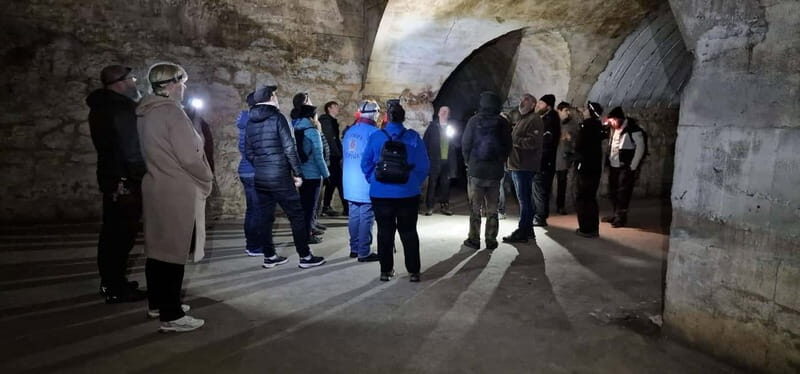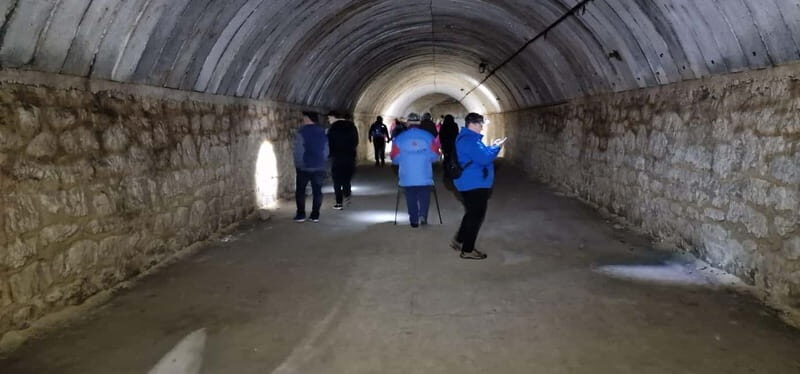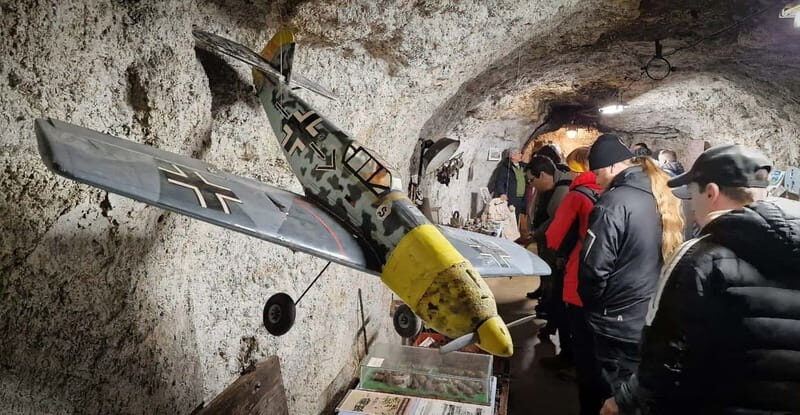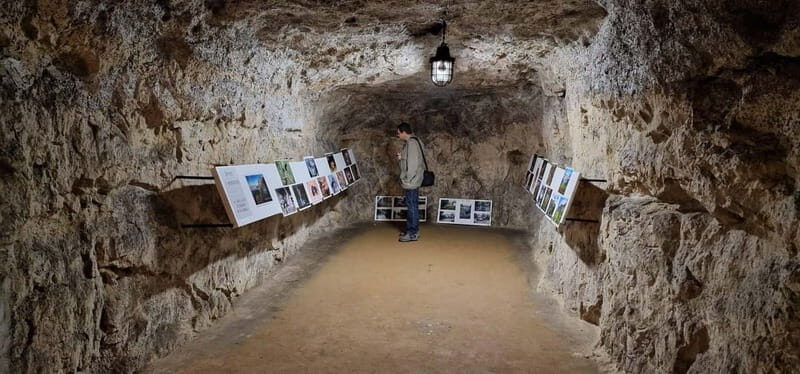Traveling through the Czech Republic offers more than just charming towns and scenic landscapes; it also presents opportunities to reflect on the darker chapters of history. The Rabtejn tour in Ústí nad Labem takes visitors on a sobering journey into a site that once served as a subcamp of Flossenburg, offering a rare glimpse into the wartime past—and the resilience of those who endured it. For just about two hours, you’ll walk through remains of underground tunnels, view exhibits of artifacts, and learn from knowledgeable guides who bring this history to life.
What makes this tour especially compelling are the underground labyrinths and exhibits dedicated to WWII air accidents—elements that add layers of authenticity to the experience. We particularly appreciated the exclusive access to underground sections, which provided a tangible sense of what life might have been like for prisoners and workers during that period. The tour is quite accessible for those interested in history, but be aware that it involves some moderate physical activity inside enclosed and dark spaces.
A potential consideration is that the underground sections are not illuminated, so you’ll need your own flashlight. Also, the underground temperature stays around 10°C, so bringing a jacket or sweater is advisable. This guided experience suits history enthusiasts, students, or anyone wanting a serious, respectful look at WWII’s impact—especially in a setting that combines both historical artifacts and the haunting remnants of underground tunnels.
Key Points

- Authentic underground experience: Access to underground labyrinths offers a rare, tangible connection to history.
- Educational exhibits: Artifacts, photographs, and documents deepen understanding of the camp’s history, including local WWII events.
- Focus on both history and nature: Besides the camp, the site covers the history of the sandstone massif and local industry.
- Moderate physical activity: Be prepared for walking and navigating dark, uneven underground corridors.
- Guided tour: Knowledgeable guides provide context and answer questions, enhancing the experience.
- Flexible booking options: Cancel up to 24 hours in advance, and reserve now to keep plans flexible.
An In-Depth Look at the Rabtejn Guided Tour

Setting the Scene: A Site of Transformation and Remembrance
The Rabtejn area has a layered history. The name itself comes from a sandstone massif resembling a raven (Rabe), which was destroyed by mining long ago, but the name stuck. This used to be a thriving industrial site in the late 19th and early 20th centuries, with cotton spinning mills employing about 1,000 workers—an episode of local prosperity that later faded. Post-1918, the industry declined, but during WWII, the site took on a new, darker role as a war production center and a place of imprisonment.
In October 1942, the concentration camp was established as a branch of Flossenburg, quickly transforming it into a site of forced labor. Prisoners built 17,500 square meters of tunnels and 4.5 km of corridors within 8 months—a feat that still echoes in the underground labyrinths you’ll explore. After liberation, the site served as an internment and resettlement camp, but today, it stands as a stark reminder of wartime suffering, with exhibits and remains preserved to educate visitors.
The Tour Begins: History Comes to Life
Your guide, Fabián or another knowledgeable local, kicks off the tour with an overview of Rabtejn’s history. The narrative centers on how the site evolved from an industrial hub to a concentration camp, emphasizing the human stories behind the stones. As you listen, you’ll get a sense of how local industry was repurposed for war—production of parts for Junkers bombers and Messerschmitt fighters, which was later moved underground for safety.
This initial part sets a respectful tone, recognizing the suffering and resilience of those imprisoned there. We appreciated Fabián’s balanced approach, not shying away from the harsh realities but also highlighting the local community’s complex history with the site.
Inside the Underground Labyrinths: A Closer Look at the Past
The core of the experience is exploring the underground tunnels—specifically the Werk C and Werk B complexes. The first, Werk C, is an exhibition space housed within the tunnels, containing artifacts, photographs, and documents that tell stories of both the camp and the local area’s natural history, including airplane crash sites. It’s fascinating and sobering to see actual relics and visualize the conditions prisoners endured.
The second complex, Werk B, requires you to bring your own flashlight, as it’s unlit. This part feels very authentic—walking through dark, narrow corridors that echo the sounds of history. The tunnels bring a visceral understanding, and many find it emotionally impactful. The real-life sense of being in a confined space adds weight to the stories of imprisonment and forced labor.
More Great Tours NearbyWhat You’ll See and Learn
- Camp remains: The stone structures and tunnels, with explanations of their purpose during WWII.
- Exhibitions: Artifacts, photographs, and documents related to the camp, including information about airplane accidents in the surrounding area.
- Historical context: How Rabtejn’s role shifted over time—from industry to war effort, and finally as a camp.
- Local history: The story of the sandstone massif and its destruction through mining, a reminder that even natural landmarks are changed by human activity.
- Post-war use: The transition from a camp to an internment and resettlement site after liberation.
Practical Tips for Visitors
Given the underground environment, bring comfortable shoes and a jacket or sweater—the temperature is around 10°C. You’ll also need your own flashlight for the second underground complex, so consider bringing a small headlamp or flashlight. Photography is allowed, so you might want to capture some of the haunting corridors or exhibits.
Since the tour involves some walking and navigating uneven underground passages, it’s not suitable for children under 6, those with claustrophobia, or wheelchair users. The guided format ensures that everyone can follow along and ask questions, creating a respectful, informative atmosphere.
The Value of the Experience
While the tour is priced reasonably, it’s the quality of the access and storytelling that makes it worthwhile. The exclusive access to underground tunnels—not often open to the public—is a major highlight, providing a rare glimpse into wartime construction and daily life within the camp. The combination of outdoor historical context, underground exploration, and exhibits offers a well-rounded understanding of this complex site.
What Reviewers Love
Travelers have expressed appreciation for the knowledgeable guides and the chance to see underground sections that aren’t usually accessible. One reviewer called it “a highly emotional and educational experience,” particularly emphasizing how the underground tunnels made history feel real and immediate. Others mentioned that it’s a respectful tribute that balances historical facts with thoughtful storytelling, which is crucial when visiting sites of such tragic significance.
Possible Drawbacks
Some might find the underground tunnels a bit claustrophobic or cold, so if you’re sensitive to enclosed spaces or cold environments, plan accordingly. Also, since the tour is only two hours, it covers a lot of ground quickly—if you’re particularly interested in WWII history, you might want to supplement this with additional visits or reading.
Who Should Consider This Tour?

This experience is perfect for history buffs, students, or anyone interested in the WWII era looking for a meaningful, authentic experience. It’s also suitable for travelers who appreciate underground exploration and are not deterred by confined spaces. If you’re traveling with family, children over 6 who can handle walking and darkness may enjoy the tour, but those with claustrophobia or mobility issues should consider alternatives.
FAQs

Is the tour suitable for children?
Children under 6 are not recommended because of the underground tunnels and the nature of the history. Older children who can handle walking and darkness may enjoy it, but parental discretion is advised.
Do I need to bring my own flashlight?
Yes, for the second underground complex (Werk B), you will need your own light source, such as a flashlight or headlamp.
How long does the tour last?
The guided tour is approximately 2 hours, including the exploration of tunnels and exhibits.
Are there any restrictions on photography?
Photography is allowed, which allows you to capture some of the haunting underground corridors and exhibits.
Is there any transportation provided?
No, transport is not included. The meeting point is at a designated parking area in Janská.
What should I wear?
Wear comfortable walking shoes, and bring a jacket or sweater because the underground temperature is around 10°C.
Final Thoughts
Visiting Rabtejn on this guided tour offers a rare chance to connect directly with a site that once held prisoners, workers, and war efforts. It’s a sober, thought-provoking experience that invites reflection on the darker elements of history while highlighting resilience and the importance of remembrance. The combination of outdoor remains, underground tunnels, and detailed exhibits makes this a compelling stop for anyone interested in understanding the full story behind the scars of WWII in the Czech Republic.
If you’re seeking an experience that’s authentic, respectful, and educational—one that leaves you with more questions than answers but a deeper appreciation for the past—this tour is well worth your time. It’s best suited for those comfortable with confined spaces and eager to learn about a lesser-known chapter of WWII history in a tranquil, scenic setting.
Note: Always check availability and book in advance, as the tour runs on specific schedules and can fill up quickly. Remember to arrive prepared for a walk and underground exploration, and keep an open mind—history here is powerful and sobering, but also vital to understanding our shared past.
You can check availability for your dates here: